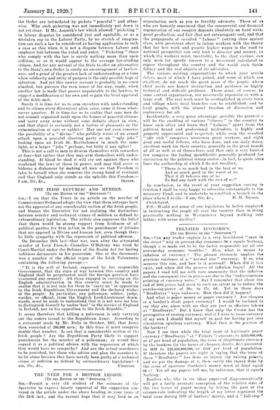FRENZIED ECONOMICS. [To THE EDITOR OF THE " SPECTATOR."]
Sin,—Can any reader explain to a very bewildered "man in the street" why in present-day economics 90 x equals Nothing. though x is made out to Ile the factor responsible for all our present-day economic troubles ? Also, what is meant by inflation of currency ? The phrase obviously implies the previous existence of a " normal size " currency. If so, who assesses this size, and how is it assessed? 'When did it last exist, and when did the process of inflation begin? All the papers I read tell use with rare unanimity that the inflation and the consequent rise in prices are due to the "indiscriminate printing of currency notes." But I remember that about the end of 1913 prices had risen to such an extent as to reduce the purchasing-power of 20s. to 17s. Gd. Yet in those days " Bradburys " were unknown. How then did it happen?
And what is paper money or paper currency ? Are cheques or a banker's draft paper currency? I would be inclined to say they are, since with me they are just as effective tokens as "Bradburys." But I know that only the Crown has the Prerogative of issuing currency, and if I were to issue currency of my own I should find myself in gaol for having put into circulation spurious currency. What then is the pcsition of the bankers?
Now I see that while the total issue of legitimate paper currency ("Bradburys "or "Fishers ") amounts to £315,000,000. or £7 per head of population, the issue of illegitimate currency by the bankers (in the forms of cheques, drafts, &c.) amounted* in 1919 to 08,450,000,000, or £631 per head of population. If therefore the papers are right in saying that the issue cd these " Bradburys " has done us injury (by raising prises), and we put the damage at x, then surely the injury done by the issue of spurious (bankers') money must at least equal 90 x! Yet all my papers tell me, by inference, that it equals Nothing.
Readers who like to see ideas expressed diagrammatically will get a fairly accurate conception of the relative sizes of the two issues of paper money by letting the part of the column-rule indicating the length of my letter represent the total issue during 1919 of bankers' money, and a " full-stop " represent the total issue of "Bradburye." This may help to make clearer the amazing argument of present-day economists that the ninetieth part of the whole is enormously larger than the whole, since the whole itself is by general assent
assumed to equal Nothing am, Sir. a., BETA.
[A cheque drawn on a bank normally represents so much money actually held by the bank on behalf of the customer. There is, in fact, something behind the cheque. If there were not, the cheque would be returned to any one who tried to cash It marked "Refer to drawer." But there is, alas nothing behind a " Bradbury." It is high time that the printing-presses which turn them out should slow down. At the same time we agree, and have often said, that the lending of money by bankers for War Loan purposes has inevitably added to the geueral infiation.—ED. Spectator.]



































 Previous page
Previous page